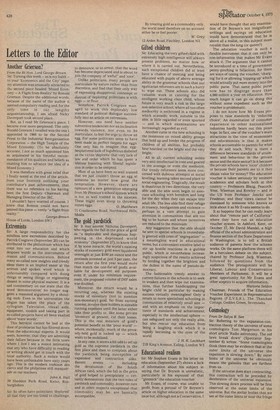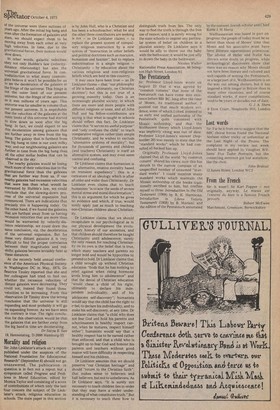Cosmology
From Dr Satya B. Sen
Sir: Referring to the expansion-contraction theory of the universe of some cosmologists Tom Margerison in his short article 'Radio astronomy. The old laws break down' (Spectator September 6) writes: "Some cosmologists think there may be evidence that at the outer limits of the universe the expansion is slowing down." By outer limits of the universe he obviously means the galaxies that are farthest from us.
If the universe does start contracting, this contraction will be preceded by deceleration of the universal expansion. This slowing down process will be first observed at the outer limits of the universe. But the stellar bodies that we see at the outer limits or near the fringe
of the universe were there millions of Years ago. After the initial big bang and even after the formation of galaxies and stars, we should expect thein to be Moving away from each other at very high velocities. In time, due to the gravitational forces, their motion would Slow down.
In other words, galactic velocities obey not only Hubbies law (velocitydistance relationship) but also the universal gravitational force. In contradistinction to what many cosmologists believe it won't be possible, for us to see the deceleration of the galaxies at the fringe of the universe. This fringe is not the outer limit of our present universe, but the fringe of the universe as it was millions of years ago. This universe was far smaller in volume than our present universe. It is improbable that the velocities of the galaxies at the outer limits of this universe had started to slow down so soon after the big bang. In fact, we could expect to see this deceleration among galaxies that are further away in time from the big bang. The galaxy that is farthest from the big bang in time is our own milky way, and our neighbouring galaxies are further in time from the big bang than all the other stellar bodies that can be observed in the sky.
The nearby galaxies would be losing much more of their velocities due to the gravitational force than the galaxies that are further way from us. If our nearby galaxies had recession velocities that were less than what would be warranted by Hubble's law, we could conclude that the slowing-down process of the universal expansion had commenced. There are indications that Precisely this is happening today. On the other hand, if we found the galaxies that are farthest away from us having recession velocities that are more than would be warranted by velocity-distance relationship, we could draw the same conclusion, viz, the deceleration of the universal expansion. But for these very distant galaxies it is very difficult to find the proper correlation between their magnitudes and redshifts; galaxies become invisibly faint at these distances.
At the recently held annual confer ence of the American Physical Society in Washington DC in May, 1975, Dr Beatrice Tinsley reported that she and her colleagues had tried to find out Whether the recession velocities of distant galaxies were decreasing. They could not; instead they found these velocities to be increasing. From this observation Dr Tinsley drew the wrong conclusion that the universe is still expanding and most probably it will go on expanding forever. As we have seen the contrary is true. The right conclusion for this observation would be that the galaxies that are farther away from the big band in time are decelerating.
Dr Satya B. Sen 19, Hennenstieg, D-2000 Hamburg-53



































 Previous page
Previous page